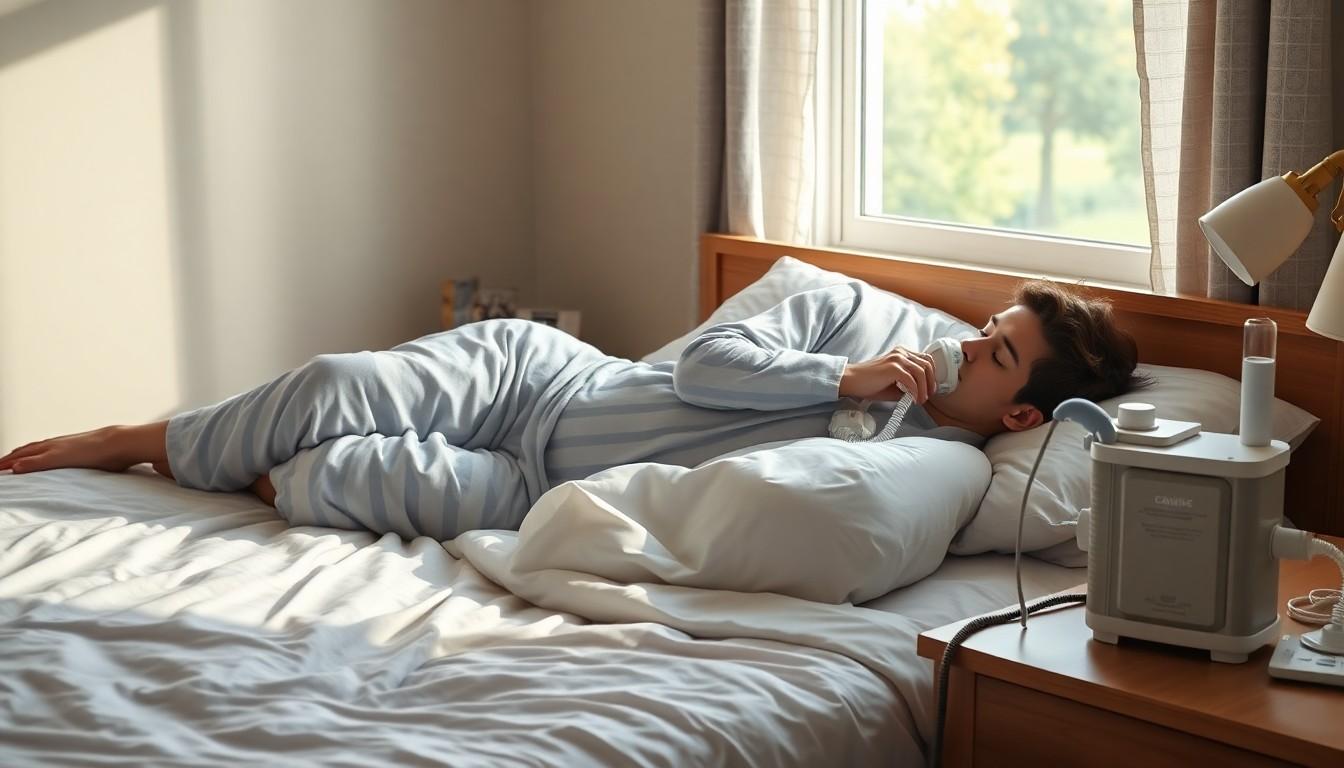Living with a deviated septum can make getting restful sleep challenging, especially for those who rely on CPAP therapy. This common nasal condition affects millions of people and can significantly impact the effectiveness of sleep apnea treatment.
When the wall between the nasal passages is crooked or off-center, it creates an obstruction that makes breathing difficult. For CPAP users, this anatomical irregularity presents unique challenges in maintaining proper airflow and achieving optimal therapeutic benefits. Understanding the relationship between CPAP therapy and a deviated septum is crucial for managing sleep apnea symptoms effectively.
Understanding CPAP Therapy and Deviated Septum
A deviated septum significantly impacts CPAP therapy effectiveness by creating additional airway resistance. The structural irregularity in the nasal passage affects how pressurized air flows during treatment.
How a Deviated Septum Affects CPAP Treatment
The deviated septum creates uneven airflow distribution during CPAP therapy, requiring pressure adjustments for optimal treatment. Common effects include:
- Increased mask leakage from compensatory pressure changes
- Reduced therapy compliance due to comfort issues
- Higher pressure requirements to overcome nasal resistance
- Mouth breathing compensation, leading to dry mouth
- Limited effectiveness of nasal CPAP masks
- Morning headaches from inadequate air pressure delivery
- Frequent mask adjustments to maintain proper seal
- Difficulty maintaining prescribed pressure levels
- Increased nose irritation or congestion
- Sleep disruptions from inconsistent airflow
- Dry throat from compensatory mouth breathing
| Symptom | Percentage of Users Affected |
|---|---|
| Mask leakage | 65% |
| Nasal congestion | 45% |
| Pressure adjustment issues | 38% |
| Morning headaches | 32% |
| Sleep disruptions | 28% |
CPAP Mask Options for Deviated Septum Patients

CPAP mask selection plays a crucial role in treatment effectiveness for individuals with a deviated septum. The right mask type accommodates breathing difficulties while maintaining proper air pressure delivery.
Full-Face Masks vs Nasal Masks
Full-face masks offer superior performance for deviated septum patients by covering both nose and mouth areas. These masks:
- Provide alternate breathing pathways through nose or mouth
- Distribute air pressure across a wider surface area
- Accommodate higher pressure settings with enhanced comfort
- Minimize air leakage issues common with nasal-only masks
Nasal masks present several limitations for deviated septum patients:
- Restrict breathing to nasal passages only
- Create pressure points due to concentrated airflow
- Increase likelihood of mask leaks
- Require additional chin straps for mouth breathers
Finding the Right Mask Fit
Essential fitting considerations for deviated septum patients include:
- Measuring facial dimensions using manufacturer sizing guides
- Testing mask seal at various sleeping positions
- Adjusting headgear straps for balanced pressure distribution
- Selecting cushion materials compatible with facial contours
- Checking for red marks or pressure points after initial use
| Fit Aspect | Optimal Range |
|------------|---------------|
| Mask Leak Rate | < 24L/min |
| Strap Tension | Finger slip test |
| Cushion Contact | 100% seal maintained |
Adjusting CPAP Pressure Settings for Septum Issues

CPAP pressure settings require precise calibration for patients with a deviated septum due to restricted nasal airflow. The anatomical irregularity creates additional resistance that impacts the effectiveness of standard pressure settings.
Working With Your Sleep Specialist
Sleep specialists conduct thorough assessments to determine optimal CPAP pressure settings through titration studies. These overnight evaluations measure breathing patterns, oxygen levels, and airway responses to different pressure levels. The specialist monitors real-time data to identify the exact pressure required to maintain open airways while accommodating the unique challenges of a deviated septum.
Pressure Recommendations
The baseline CPAP pressure settings for deviated septum patients typically range higher than standard recommendations. A titration study reveals these specific requirements:
| Pressure Considerations | Typical Values |
|---|---|
| Starting Pressure | 4-6 cm H2O |
| Maximum Pressure | 15-20 cm H2O |
| Pressure Adjustments | 2-3 cm H2O increments |
- Monitoring airway resistance during different sleep positions
- Adjusting ramp time settings for gradual pressure increases
- Setting appropriate minimum pressure levels to maintain airway patency
- Programming pressure relief features for easier exhalation
- Implementing auto-adjusting pressure modes to respond to positional changes
Alternative Solutions and Treatments

A deviated septum affects CPAP therapy effectiveness, requiring alternative treatment approaches. These solutions range from non-surgical interventions to surgical procedures.
Surgical Options to Consider
Surgical interventions offer permanent solutions for deviated septum correction. Septoplasty stands as the primary surgical procedure, realigning the nasal septum to its proper position in the center of the nose. This surgical correction improves nasal airflow by:
- Removing damaged cartilage
- Repositioning bent cartilage
- Straightening the nasal septum
- Reducing airway resistance
Complementary Therapies
Several non-surgical treatments complement CPAP therapy for deviated septum patients:
- Nasal Medications
- Decongestant sprays for short-term congestion relief
- Antihistamines for allergy-related swelling
- Nasal steroid sprays to reduce inflammation
- Nasal Hygiene Methods
- Saline nasal flushes to clear airways
- Steam inhalation for moisture retention
- Nasal strips to expand nasal passages
| Treatment Type | Duration of Effect | Best Used For |
|---|---|---|
| Decongestants | 4-6 hours | Temporary congestion |
| Nasal Steroids | 12-24 hours | Chronic inflammation |
| Saline Flushes | 2-3 hours | Daily maintenance |
These complementary approaches enhance CPAP effectiveness while managing deviated septum symptoms, creating a comprehensive treatment strategy.
Tips for Better CPAP Compliance with a Deviated Septum

CPAP users with a deviated septum can enhance their therapy experience through specific adjustments to their sleeping environment and equipment settings. These targeted modifications address common challenges while improving comfort and treatment effectiveness.
Position Adjustments
Side sleeping positions optimize airflow for CPAP users with a deviated septum. A body pillow maintains proper alignment during sleep while reducing nasal congestion. Strategic pillow placement includes:
- Positioning a wedge pillow at a 30-45 degree angle to minimize pressure on nasal passages
- Using cervical pillows to maintain proper neck alignment
- Placing body pillows parallel to the torso for enhanced side-sleeping stability
- Setting humidity levels between 4-6 on the CPAP machine’s display
- Adjusting temperature settings to prevent condensation in the mask
- Using heated tubing to maintain consistent air moisture levels
- Monitoring room temperature between 68-72°F (20-22°C) to optimize humidification
| Humidity Level | Purpose | Benefit |
|---|---|---|
| Low (1-3) | Minimal moisture | Prevents over-humidification |
| Medium (4-6) | Optimal comfort | Reduces nasal irritation |
| High (7-8) | Maximum moisture | Helps with severe dryness |
Conclusion
Living with both a deviated septum and sleep apnea requires careful attention to CPAP therapy management. Finding the right combination of mask type pressure settings and treatment methods plays a vital role in achieving optimal results. Whether through surgical correction complementary therapies or equipment adjustments patients can significantly improve their treatment outcomes.
Working closely with healthcare providers to develop personalized solutions will help overcome the unique challenges of using CPAP therapy with a deviated septum. With proper management and customized approaches patients can achieve better sleep quality and enhanced therapeutic benefits from their CPAP treatment.
